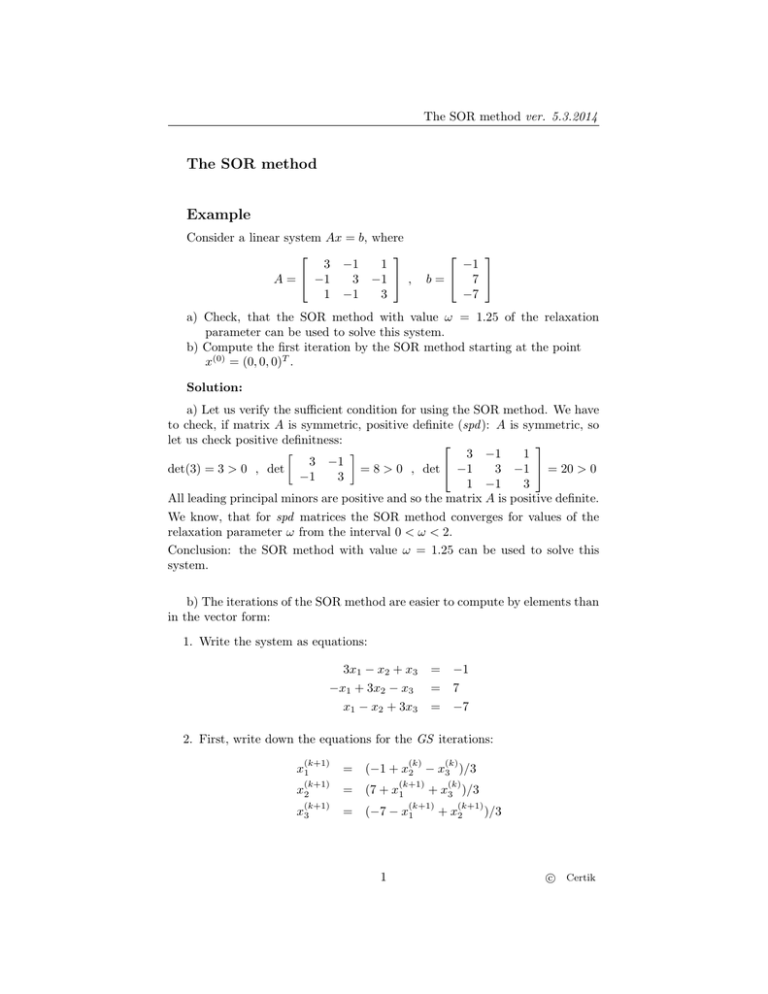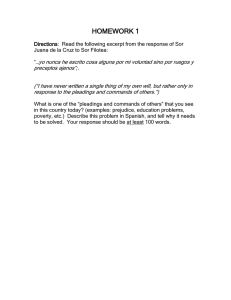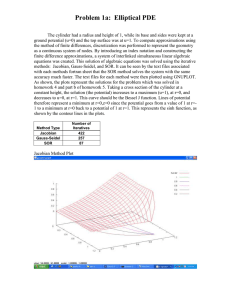The SOR method Example
advertisement

The SOR method ver. 5.3.2014 The SOR method Example Consider a linear system Ax = b, where 3 −1 1 3 −1 , A = −1 1 −1 3 −1 b= 7 −7 a) Check, that the SOR method with value ω = 1.25 of the relaxation parameter can be used to solve this system. b) Compute the first iteration by the SOR method starting at the point x(0) = (0, 0, 0)T . Solution: a) Let us verify the sufficient condition for using the SOR method. We have to check, if matrix A is symmetric, positive definite (spd ): A is symmetric, so let us check positive definitness: 3 −1 1 3 −1 3 −1 = 20 > 0 det(3) = 3 > 0 , det = 8 > 0 , det −1 −1 3 1 −1 3 All leading principal minors are positive and so the matrix A is positive definite. We know, that for spd matrices the SOR method converges for values of the relaxation parameter ω from the interval 0 < ω < 2. Conclusion: the SOR method with value ω = 1.25 can be used to solve this system. b) The iterations of the SOR method are easier to compute by elements than in the vector form: 1. Write the system as equations: 3x1 − x2 + x3 −x1 + 3x2 − x3 x1 − x2 + 3x3 = −1 = 7 = −7 2. First, write down the equations for the GS iterations: (k+1) = (−1 + x2 − x3 )/3 (k+1) = (7 + x1 (k+1) = (−7 − x1 x1 x2 x3 (k) (k+1) (k) (k+1) 1 (k) + x3 )/3 (k+1) + x2 )/3 c Certik The SOR method ver. 5.3.2014 3. Now multiply the right hand side by the parameter ω and add to it the vector x(k) from the previous iteration multiplied by the factor of (1 − ω): (k+1) = (1 − ω)x1 + ω(−1 + x2 − x3 )/3 (k+1) = (1 − ω)x2 + ω(7 + x1 (k+1) = (1 − ω)x3 + ω(−7 − x1 x1 x2 x3 (k) (k) (k) (k) (k+1) (k) (k) + x3 )/3 (k+1) (k+1) + x2 )/3 4. For k = 0, 1, 2, . . . compute x(k+1) from these equations, starting by the first one. Computation for k = 0: (1) (0) (1) (0) (1) (0) (0) (0) x1 = (1−ω)x1 +ω(−1+x2 −x3 )/3 = (1−1.25)·0+1.25·(−1+0−0)/3 = −0.41667 (1) (0) x2 = (1−ω)x2 +ω(7+x1 +x3 )/3 = −0.25·0+1.25·(7−0.41667+0)/3 = 2.7431 (1) (1) x3 = (1−ω)x3 +ω(−7−x1 +x2 )/3 = −0.25·0+1.25·(−7+0.41667+2.7431)/3 = −1.6001 The next three iterations are x(2) = (1.4972, 2.1880, −2.2288)T , x(3) = (1.0494, 1.8782, −2.0141)T , x(4) = (0.9428, 2.0007, −1.9723)T , the exact solution is equal to x = (1, 2, −2)T . 2 c Certik



